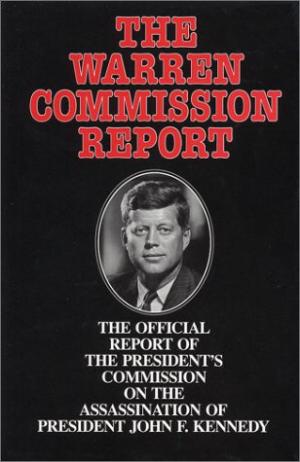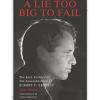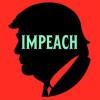The Incredible Wrongness of the Warren Report
The Official Inquiry into the Assassination of JFK Is Deeply Flawed

There was never any substantial reason to congratulate the Warren Commission for its performance.—Murray Kempton
In my article last week I explained why, based on information discovered or disclosed since the 1964 Warren Report, the Report’s principal conclusions—that there was no conspiracy behind the JFK assassination, and that Lee Harvey Oswald, acting alone, shot and killed JFK—now stand discredited. I shall now explain why a reevaluation of the Report in light of the new information requires rejection of other key aspects of the Report.
• The Report was wrong in concluding that there was nothing to support “speculation” that Oswald was an agent, employee or informant of the FBI, the CIA or any other U.S. government agency.
Today, the preponderance of evidence indicates that Oswald was an FBI informant and that he was some sort of operative for both military intelligence (the Office of Naval Intelligence) and the CIA. Oswald’s bizarre comings and goings are inexplicable unless he was an undercover U.S. intelligence asset. The evidence also indicates that the FBI and U.S. intelligence agencies lied to the Warren Commission and destroyed or withheld documents in order to cover up their pre-assassination dealings with Oswald.
• The Report was wrong in concluding that Oswald was a leftist, a Marxist or a supporter of Fidel Castro.

We can now see that Oswald’s supposed affiliations with the political left were part of what is known in the world of spies as a “legend”—a cover story created to conceal the real activities of a spy or operative. Oswald’s pro-communist or pro-Castro statements or actions involved what in the intelligence community is called “sheepdipping”—manipulated behavior intended to create a desired image. Oswald’s connections with pro-communist or pro-Castro organizations, it is now evident, were paper, not people, connections. In New Orleans, where he resided in the summer of 1963, for example, Oswald was the founder, the head, the publicist and the only member of the local Fair Play for Cuba Committee. It was entirely a put-up job. Anyone who clings to the Warren Report’s notion that Oswald admired Castro or that he did things to advance Castro’s interests has been duped.
• The Report was wrong in describing Oswald as a “loner.”
During the 18 months preceding the assassination Oswald was friends with, helped by or frequently in the company of numerous persons. To cite only a few examples, there was the aristocratic “petroleum engineer,” George DeMohrenschildt, who seems to have been assigned by the CIA to keep watch (“babysit” in the lingo of spies) on Oswald; the anti-communist crusader Guy Banister, an ex-FBI agent and a racist; and the weird and violence-prone David Ferrie, who had ties to both the CIA and the Mafia.
• The Report erred in examining JFK’s assassination without reference to various 1963 assassination plots against JFK.
It is now firmly established that in the months preceding the assassination both the Secret Service and the FBI were apprised of plots—in Chicago, Tampa and Miami—to shoot JFK from a building while he was motorcading. (The Warren Commission was not told of these plots.) The Dallas assassination therefore can no longer be viewed, as it was in the Warren Report, in isolation. It must be viewed in the context of these 1963 plots. We now know, horribly, that, as assassination researcher David Talbot starkly notes, “Kennedy was, in fact, being methodically stalked in the final weeks of his life… In the final month of his life, John Kennedy seemed a marked man, encircled by a tightening knot of treachery.”
• The Report was wrong in whitewashing the performance of the Secret Service. Although it did comment on some of the deficiencies in the agency’s protection of JFK in Dallas, it is now evident that the Report essentially glossed over the unusual, bewildering, and huge failures of the Secret Service to adequately protect JFK on Nov. 22, 1963. Today these lapses are truly astonishing in view of the Secret Service’s awareness of the recent plots to shoot JFK as he was motorcading.
• The Report was wrong in concluding, in an effort to bolster its case against Oswald, that he murdered Dallas police officer J.D. Tippit, who was shot 45 minutes after the JFK assassination.
Today it seems likely that officer Tippit was slain by one or more unknown gunmen, not Oswald. In accusing Oswald of murdering Tippit with a .38 cal. revolver, the Report relied on suspicious or inconclusive ballistics evidence, cherry-picked, coached, or unreliable eyewitnesses and improbable time-lines. Tippit’s movements in the minutes preceding his encounter with his murderer(s) are shrouded in mystery; his presence outside his assigned district has not been satisfactorily explained and the transcripts of police radio logs concerning Tippit immediately before and after his shooting are conflicting and suspicious. Why the killer(s) approached Tippit after he had fallen to the ground and shot him in the temple, execution-style, is also mysterious, since almost all shootings of police officers involve offenders who flee the scene as soon as the officer is down.
• The Report was wrong in concluding, in an effort to bolster its case again Oswald, that in April 1963, eight months before the JFK assassination, he attempted to murder retired U.S. army general Edwin Walker.
The weight of the evidence today is that whoever shot at Walker used a 30.06 cal. rifle rather than the 6.5 mm carbine Oswald allegedly used to shoot JFK; that Oswald never possessed a 30.06 cal. weapon; that whereas the carbine fired copper-jacketed bullets, the bullet fired at Walker and retrieved by police was steel-jacketed; that the attempt on Walker was committed not by Oswald (who could not drive) but by two unknown individuals who sped from the scene in separate automobiles; and that the evidence the Report relied on to pin the Walker shooting on Oswald was suspicious and unreliable.
• The Report was wrong in concluding that Jack Ruby, Oswald’s murderer, was not involved in organized crime activities and that Ruby acted alone and spontaneously.
The weight of the evidence today is that Ruby’s public explanations for murdering Oswald are not believable; that Ruby was either a member of the Mob or affiliated with mobsters; that he had a number of suspicious long-distance phone calls with underworld figures in the months preceding the JFK assassination; that while concealing the pistol he later used to shoot Oswald he stalked Oswald at the police station, beginning soon after Oswald’s arrest; that Ruby probably did not act on his own; and that Oswald’s murder was a classic gangland hit.
The basic conclusions of the Warren Report are wrong, wrong, wrong.
Donald E. Wilkes, Jr. is a professor emeritus at the University of Georgia, where he taught in the law school for 40 years. This is his 37th published article on the JFK assassination.












comments